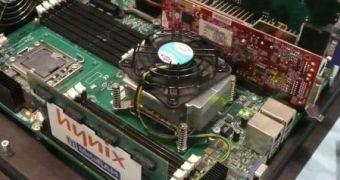Intel's upcoming Nehalem processors seem to promise a lot in terms of performance, although the chip manufacturer did not deliver the whole picture. Among the bits of information in the Nehalem puzzle, Intel has hinted users at the chip's capabilities to work with huge amounts of memory, namely 288 GB of pure DDR3 RAM.
One of the systems showcased during last week's Intel Developer Forum was comprised of a dual-socket, six-channel DDR3 Tylersburg DP Gainestown-based motherboard, brewed in-house by the company. Aimed at the server market, the new board comes with six DDR3-1333 DIMM sockets per processor, which means that it can support no less than 12 memory modules.
The memory behemoth was built with MetaRAM Hynix memory modules. Needless to say that such performance is meant to be admired, and Intel took care to run its test shuttle without a protective casing. The system was stripped to the bone and would run with just one of the two CPU sockets occupied, as well as with only one 8 GB MetaRAM Hynix DDR3 DIMM.
This could be the beginning of a completely new breed of motherboards, that can accept as much as 9 DDR3-1066 channels per GPU, or 18 channels per motherboard. Given the fact that 16 GB memory modules can be created, when populating all the 18 DIMM channels with 16 GB memory modules, Intel can achieve a motherboard with no less than 288 GB of RAM.
Of course, such amount of system memory won't be used for a Counter-Strike shootout with the guys on the LAN, but there are plenty of applications that could benefit from the incredible memory horsepower. The chip manufacturer demonstrated the miniature supercomputer running memory-intensive software.
The test was carried using ATI's recently introduced FireGL 7700 DisplayPort workstation graphics card, but let's not forget that the Larrabee silicon is just around the corner, and it will come with an impressive boost in graphics performance.

 14 DAY TRIAL //
14 DAY TRIAL //